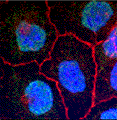Biochemistry, Department of
Date of this Version
2016
Citation
Med. Chem. Commun., 2016, 7, 612–622
DOI: 10.1039/c6md00043f
Abstract
The fatty acid transport proteins (FATP) are classified as members of the solute carrier 27 (Slc27) family of proteins based on their ability to function in the transport of exogenous fatty acids. These proteins, when localized to the plasma membrane or at intracellular membrane junctions with the endoplasmic reticulum, function as a gate in the regulated transport of fatty acids and thus represent a therapeutic target to delimit the acquisition of fatty acids that contribute to disease as in the case of fatty acid overload. To date, FATP1, FATP2, and FATP4 have been used as targets in the selection of small molecule inhibitors with the goal of treating insulin resistance and attenuating dietary absorption of fatty acids. Several studies targeting FATP1 and FATP4 for drug development were based on the intrinsic acyl CoA synthetase activity of these proteins and not on transport directly. While several classes of compounds were identified as potential inhibitors of fatty acid transport, in vivo studies using a mouse model failed to provide evidence these compounds were effective in blocking or attenuating fatty acid transport. Our studies targeting FATP2 employed a naturally occurring splice variant, FATP2b, which lacks intrinsic acyl CoA synthetase due to the deletion of exon 3, yet is fully functional in fatty acid transport. These studies identified two compounds, 5′-bromo-5-phenyl-spiroij3H- 1,3,4-thiadiazole-2,3′-indoline]-2′-one), now referred to as Lipofermata, and 2-benzyl-3-(4-chlorophenyl)-5- (4-nitrophenyl)pyrazoloij1,5-a]pyrimidin-7IJ4H)-one, now called Grassofermata, that are effective fatty acid transport inhibitors both in vitro using a series of model cell lines and in vivo using a mouse model.
Included in
Biochemistry Commons, Biotechnology Commons, Other Biochemistry, Biophysics, and Structural Biology Commons


Comments
This journal is © The Royal Society of Chemistry 2016